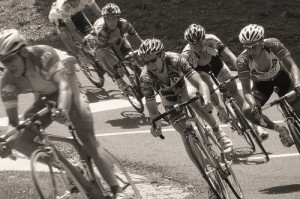Most cyclists who are participating in races have a solid control of themselves and their bicycles and will be safe riding in a competitive setting. Nonetheless, injury and death still occur, even to the professionals. Consequently, here are some safety tips which may help prevent injury and give a rider confidence as he or she participates in a race.
7 Safety Tips for Racers
We would like to encourage cyclists to meet racing goals while respecting others on the road and avoiding preventable accidents. The Century Road Club Association (CRCA) reminds racers that although everyone is mostly following the same rules, “how each racer remembers, interprets, and executes the rules may be as different as the number of racers.”
Here are tips, provided by CRCA, for staying safe as you race to the finish line:
 Identify risky situations and racers, and then avoid them.
Identify risky situations and racers, and then avoid them.- Be predictable—maintain a smooth straight line without sudden changes in course.
- In racing, there will often be a number of individuals around you; keep your eyes on the road.
- Communicate to others with verbal or hand signals.
- Don’t overexert yourself.
- Maintain your bicycle.
- Know your tolerances since becoming frustrated, exhausted, or anxious can hamper sharp decision-making skills
In addition, it is wise to know the rules of the race you are competing in. National rules are provided by USA Cycling in the Race Official’s Administrative Handbook (although it is currently under revision). International rules are provided by Union Cycliste International in it’s UCI Cycling Regulations Manual.
The Most Important Safety Measure
Many of the most important safety measures are the ones done before your race. Perhaps the most important of these safety measures is the training that a rider does in preparation for the race. SF bike.org states:
“Well-planned-out hours in the saddle are what you need to develop endurance and hone skills and techniques needed to be both a competitive and safe racer.”
Building endurance might protect you from an accident with another rider, but it will also protect against long-term injuries accrued by heavy and continual strain from an under-trained racer. The simple fact is that many racers push harder than they are ready for and experience injury from it. In addition, training will develop the familiarity with steering, turning, and overall skill to make a ride responsive to the most sudden and frightening occurrences. Overall, your preparation through training will offer the endurance, skills, and fitness that are necessary to stay alert in a race from beginning to end.
At Christensen and Hymas, we are advocates for safety as well as justice. As cyclists ourselves, we wish you exciting and eventful races, but never at the compromise of safety. For questions about our services, you can reach us at 801-506-0800. If you have been injured in a cycling accident, you can schedule a free initial consultation over the phone. If you have expensive medical bills and personal pain, we can assist you and help you receive the compensation you deserve.
Image courtesy of Joiseyshowaa on Flickr
